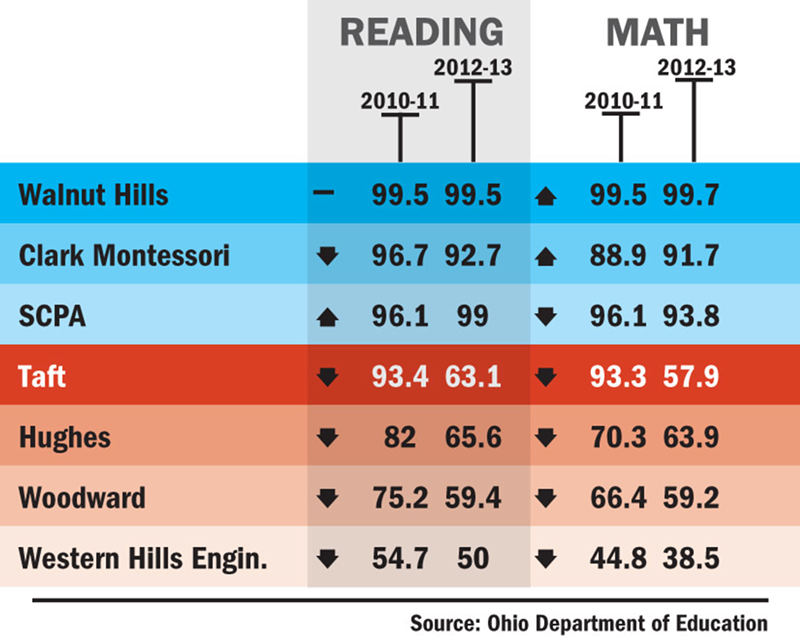Three years after basking in the national spotlight for transforming from a failing inner-city school to a model of academic excellence, Robert A. Taft Information Technology High School is showing signs of relapsing.
Local education officials across Ohio are digesting new state-issued “report cards” that, for the first time, rate public schools and school districts by a series of letter grades instead of modifiers such as “excellent” and “effective.” On the crucial measure requiring at least 75 percent of students of individual schools to pass Ohio standardized subject tests, more than half of the state’s 610 school districts received A grades, including perennial standouts like Sycamore, Lakota and Mariemont. But every big-city public school system in Ohio got F’s. Cincinnati Public Schools was the highest-scoring of those, but reaching the state’s test-passage threshold less than half the time cost it an F-bomb.
A look at the report cards for each of the city’s 56 public schools leaves it abundantly clear where that F came from. Of those 56 schools, 39 received an F in the Ohio Graduation Test-passage category. Only five got a B, while A’s — as conferred to Walnut Hills High School and Hyde Park and Kilgour elementary schools — bordered on rare.
Then there’s the truly enigmatic performance of Taft High School. For four straight years, through 2011-12, the 10th-grade class made shambles of the 75 percent passage rate on all five OGT subject tests, typically clearing 90 percent. Based in large part on its students’ aptitude on the OGT, Taft joined Walnut Hills as an excellent-rated school in 2009-10 and 2010-11. In 2010, Taft won even more prestige with a National Blue Ribbon award from the U.S. Department of Education.
No such ribbons will be landing anew in the Taft trophy cabinet. This spring its 10th-graders failed to achieve the 75 percent passage rate on all five of the OGT subject tests — reading, math, writing, social studies and science. With passage rates of 63 percent on reading, 58 percent on math and 41 percent on social studies, Taft’s 10th-grade class last year was, all at once, significantly less smart than the class ahead of it, significantly behind the 10th-grade average of CPS as a whole and comparable to the Taft 10th-grade class of 2004-05, when Taft was rated by the state as an “academic emergency.”
CPS spokeswoman Janet Walsh said Taft’s 10th-grade performance on the OGT is “pretty much unacceptable.” She was quick to point out, though, that the school did not have a permanent principal for two years following the departure of Anthony Smith, who was credited with the school’s turnaround. He was promoted to CPS assistant superintendent in the fall of 2011 and is now superintendent of Winton Woods City Schools. “It’s hard to speculate why scores drop, but as to Taft, I will say that they’ve had a lot of changes at the leadership level after Anthony left, and sometimes that plays a part,” Walsh said.
Taft now falls to a rookie principal Michael Turner, a Taft administrator who just got his principal’s license in April. Turner did not return three phone calls from CityBeat to his office and mobile phone.
Despite the OGT struggles of its current junior class, Taft is on solid ground with its seniors. As of last spring, enough of those students had passed the OGT subject tests to get Taft past the 75 percent barrier. Nearly 95 percent of them, for example, had passed the reading OGT, 90 percent the math. A larger number of students at any school pass the OGT tests after another year of instruction, but at Taft, 11th-graders also draw the bulk of attention from volunteer tutors from Cincinnati Bell.
Taft’s ascent to excellence under Smith, while trumpeted nationally, remains vexing. CPS began giving the national ACT test to all 11th-graders in 2010, and Taft’s average composite scores were tied for lowest in the district. In 2006, CPS refused to investigate findings by a state contractor that, of 1,707 erasures of answers to OGT multiple-choice questions, 88 percent went from wrong to right, a result that national test experts found “not logical” and “odd.” CityBeat reported the story in February 2012, and neither CPS Superintendent Mary Ronan nor the Cincinnati Board of Education gave the matter a further look.
CONTACT JAMES MCNAIR: [email protected]


